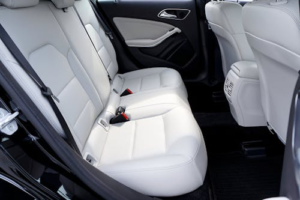Most people immediately think of tire rotations, oil changes, or maybe a new coat of wax on the outside of the car when they think about auto maintenance. Major advantages of car interior detailing. Even while these are important, many people overlook a crucial factor: inside car detailing. Interior detailing goes above and above, thoroughly cleaning every nook and cranny of your car’s cabin, in contrast to a simple cleaning or vacuuming operation.
Whether you drive for a ridesharing service, commute every day, or simply want a neat and orderly environment, there are several long-term advantages to investing in interior car detailing. In this post, we’ll delve into the main benefits of automobile interior detailing in great detail, including enhanced longevity, increased resale value, and improved health benefits.
What is car interior detailing?
The comprehensive cleaning and restoration of a car’s inside cabin is known as “car interior detailing”. This involves sanitizing surfaces like
- Seats (vinyl, leather, or fabric)
- Floor mats and carpets
- The console and dashboard
- Panels for doors
- Vents for air
- Mirrors and windows
- Headliners and the trunk
To bring your car’s interior back to like-new condition, professional detailers frequently combine steam cleaning, shampooing, leather conditioning, and odor neutralizers.
Major advantages of car interior detailing
Beyond simply maintaining a clean appearance, car interior detailing improves your driving experience, protects the value of your car, and fosters a healthier atmosphere. Detailing keeps the interior of your car in top shape by preventing wear and tear on dashboards and seats, as well as eliminating odors and stains that are difficult to get rid of. Additionally, it improves air quality, gets rid of allergies, and makes the environment cozy and clutter-free. Regular interior detailing offers long-lasting advantages that go beyond superficial cleaning, whether you’re getting ready to sell your car or just want a more pleasurable ride.
1. Improved Air Quality
- Improving the air quality inside a car is one of the most underappreciated yet significant advantages of interior detailing. Dust, pollen, food particles, and pet dander build up over time in hard-to-reach places like upholstery fibers, under seats, and within air vents. How Detailing Helps:
- Allergens and contaminants are eliminated by steam cleaning and deep vacuuming.
- The chance of breathing in bacteria or mold is reduced when air vents are cleaned.
- Treatments that neutralize odors Get rid of persistent pet, food, or smoke odors.
The end effect is a healthier, fresher, and cleaner atmosphere that is especially advantageous for those who suffer from respiratory disorders, allergies, or asthma.
2. Preservation of Interior Materials
- The inside surfaces of your car may suffer from regular exposure to sunshine, rain, grime, and normal wear and tear. Plastics can fade or become brittle, leather can split, and fabric can get stained. How Detailing Helps:
- To stop fading and cracking, UV protectants are applied to vinyl surfaces and dashboards.
- Leather treatment prevents cracking and keeps leather supple and smooth.
- Treatments for stain removal shield carpets and seats from long-term harm.
Frequent detailing prolongs the life of materials and avoids expensive repairs or replacements while preserving the interior structural integrity and aesthetics of your vehicle.
3. A higher value for resale
A well-kept interior might make all the difference if you intend to sell or trade in your car. A clean, odor-free, and undamaged cabin conveys to prospective purchasers that the vehicle has been well-maintained. How Detailing Helps:
- Makes a fantastic first impression when driving or inspecting.
- shows that you are dedicated to keeping your car maintained.
- can assist you in negotiating a better trade-in value or pricing.
The Kelley Blue Book states that interior quality can have a substantial impact on your car’s worth, potentially affecting its resale value by several hundred dollars or more.
4. A Better Experience When Driving
The majority of your time is spent inside your car. A neat and orderly cabin can boost your attitude and focus, whether you’re on a lengthy road trip or just a quick trip to the grocery store. How Detailing Helps:
- Gets rid of ugly dirt and clutter.
- lessens the optical strain brought on by filthy surfaces or smudged glass.
- Improves comfort by using fresh air and clean chairs.
Driving is more pleasurable and concentrated in a clean atmosphere.
5. Stopping the Growth of Mold and Bacteria
- Humidity, food particles, and spilled beverages can easily convert your automobile into a haven for mold, mildew, and bacteria, particularly under seats and on carpets. How Detailing Helps:
- High-touch surfaces like grips, gear changes, and steering wheels are cleaned with antibacterial solutions.
- Bacteria and mold spores that are concealed in upholstery and textiles are eliminated by steam washing.
- Odor eliminators get rid of any traces of rot or mildew.
This is particularly crucial if you frequently use your car for deliveries or ridesharing, or if you transport kids or pets.

6. Elimination of Odor
Odors can seep into carpets and upholstery in cars, making driving uncomfortable and even embarrassing for other passengers.
- The benefits of detailing include the removal of odor-causing particles from deep within textiles.
- uses ozone treatments and professional-grade deodorizers to eliminate odors.
- addresses the root causes of food, pet, smoke, and chemical odors.
This gives your automobile a new scent instead of one that is only momentarily covered up by air fresheners.
7. Personalization and Expert Treatment
The needs of various drivers and vehicles vary. While a premium vehicle with leather upholstery will benefit more from conditioning treatments, a family vehicle with young children may require stain and spill protection. How Detailing Helps:
- Provides personalized packages according to usage and interior materials.
- Experts are taught to apply the proper products for particular surfaces, such as leather, suede, or Alcantara.
- makes use of pH-balanced, non-damaging materials to safeguard your investment.
Personalized treatment guarantees that the interior of your car receives the care it needs.
8. Saving Time and Effort
DIY interior cleaning is a time-consuming and frequently unsuccessful endeavor for many automobile owners. Professional equipment and supplies are used in interior detailing services to complete the task more rapidly and completely.
- The benefits of detailing include saving hours of vacuuming and scouring.
- makes use of powerful extraction equipment that most customers cannot afford.
- produces better, more durable results than do-it-yourself cleaning.
You still get the advantages of a brand-new automobile interior while saving time.
9. Defense Against Decreasing Value
Automobiles are assets that lose value. Although depreciation cannot be stopped, it can be slowed down by routine maintenance, such as interior detailing, which maintains the vehicle’s general condition. How Detailing Helps:
- Preserves your car’s original appearance and feel.
- avoids damage that would require expensive repairs.
- prolongs the viability of trade-in and resale possibilities.
Detailing is essentially a way to protect your assets.
10. Expert Evaluation and Guidance
Professionals frequently find possible problems you could have missed during a detailing session, like leaks, mold on the carpet, or cracked leather. How Detailing Helps:
- Makes it possible to identify problems early on before they become more serious.
- Experts might suggest preventative care, including UV protection films or window tinting.
- You receive professional advice on how to take longer-term care of your interior.
Making sure everything inside the car is clean, fresh, and operating at its peak is like getting a small health exam.
How Frequently Should the Interior of Your Car Be Detailed?
Your lifestyle, how often you drive, and the weather all affect how often you do this. But generally speaking:
- For average drivers, every three to six months.
- For pet owners or rideshare drivers, every 1-2 months.
- seasonally for people who reside in areas with harsh weather.
- Instead of attempting to undo months (or years) of negligence, routine detailing guarantees constant upkeep.
What Does an Interior Detailing Package Usually Include?
A complete interior detailing typically entails a thorough cleaning and restoration procedure intended to revitalize every area of the car’s cabin, while each supplier may offer different packages depending on their services and areas of specialization. Carpets, seats, and floor mats are usually deep vacuumed; upholstery and fabric surfaces are shampooed or steam cleaned; leather seats are cleaned and conditioned; the dashboard, console, door panels, and cup holders are meticulously cleaned and sanitized; air vents and crevices are thoroughly cleaned; interior windows and mirrors are cleaned; and deodorizing treatments are applied to get rid of odors.
- Vacuuming the trunk, seats, and carpets
- Cleaning carpets using steam or shampoo
- Removal of upholstery stains
- Cleaning and conditioning leather
- Cleaning of the door panels, console, and dashboard
- Details of the cup holder and air vent
- Cleaning of interior mirrors and glass
- Odor treatment and deodorization
Conclusion:
What are the major advantages of car interior detailing? Of course. The benefits of polishing a car’s inside extend well beyond its tidy appearance. Over time, this investment yields significant returns in the areas of health and hygiene, vehicle preservation, and resale value. Detailing is a proactive approach to keeping your automobile in peak shape, whether you’re a car fanatic or just want to drive more comfortably and hygienically.
Frequently asked questions (FAQ)
Q1: What is the duration of an inside automobile detailing session?
Depending on a few variables, an average interior detailing session can last anywhere from one and a half to four hours. These include of the vehicle’s dimensions (small versus SUV or van), the inside condition (little dirt versus significant staining), and the services offered as part of the detailing package (e.g., basic vacuuming versus full steam cleaning, leather conditioning, etc.). It might take longer for cars that are really dirty or that need mold treatment or odor removal. For faster results, some premium services could provide expedited packages.
Q2: Can leather chairs be safely detailed inside?
Yes, interior detailing is totally safe for leather surfaces when done by experts. Skilled detailers employ pH-balanced, leather-safe cleaners and conditioners that are made especially to clean without drying out, discoloring, or cracking leather. Regular leather conditioning during detailing can actually prolong the life of your seats by keeping them smooth, supple, and impervious to wear, stains, and UV rays.
Q3: Can the smell of cigarette smoke be eliminated by detailing?
Indeed, cigarette smoke odors can be greatly diminished or even eliminated with interior finishing. Expert detailers employ a variety of thorough cleaning techniques, including enzymatic deodorizers, ozone treatments, HVAC system treatment, and steam cleaning upholstery. Your car will smell clean and fresh thanks to these cutting-edge methods that eliminate the scent at its source rather than merely covering it up with air fresheners.
Q4: Will allergies be alleviated by interior detailing?
Of course. Eliminating allergens like dust mites, pet dander, pollen, and mold spores is one of the main health advantages of interior detailing. Detailing removes allergens that frequently build up in upholstery, carpets, and behind seats by thoroughly vacuuming, cleaning air vents, and using steam treatment. Regular interior detailing can significantly improve the comfort and respiratory health of drivers who have asthma or seasonal allergies.
Q5: What is the average cost of interior detailing?
Your location, the size of your car, and the amount of care you want can all have a significant impact on the cost of interior detailing. You should budget between $100 and $300 on average. Sedans and compact automobiles may be at the lower end of the spectrum. Due to their increased surface area, larger vehicles like SUVs and vans typically cost more. Additional fees may apply for premium services, such as odor removal, pet hair removal, or leather treatment. Even if the initial outlay may seem high, the long-term benefits for your car’s value, cleanliness, and overall health make it well worth the investment.








